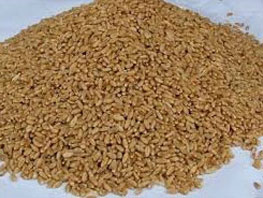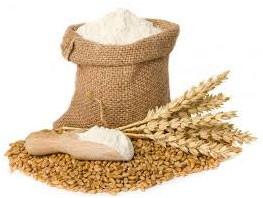- Gluten (On wet Basis) : 25% Min.
- Protein : 12.0 % Min.
- Moisture : 13.0 % .
- Test weight : 78 Kg/HL Min.
- Foreign Matter :2 % Max.
- Damaged : 2 % Max.
- Shriveled / Shrunken : 3% Max.
- Broken : 3% Max.
- Shipped : Bulk in Container's

Protein - min 13% on dry basis
Ash - min 0.75%- max 1%
Moisture - max 12%
Wet Gluten - min 30%
100% pass thru - US Mesh 50
80% pass thru - US Mesh 100
Protein - min 12% on dry basis
Ash - min 0.75%- max 1%
Moisture - max 14%
Wet Gluten - min 26%
100% pass thru - US Mesh 50
80% pass thru - US Mesh 100
Protein - min 10% on dry basis
Ash - min 0.75%- max 1%
Moisture - max 14%
Wet Gluten - min 24%
100% pass thru - US Mesh 50
80% pass thru - US Mesh 100
- Test Weight: 80 lbs/Bushel Min
- Protein: 14% Min
- Moisture: 12% max
- Wet Gluten: 27% Min
- Dry Gluten: 9% Max

Protein - min 13% on dry basis
Ash - min 0.75%- max 1%
Moisture - max 12%
Wet Gluten - min 30%
100% pass thru - US Mesh 50
80% pass thru - US Mesh 100
Protein - min 12% on dry basis
Ash - min 0.75%- max 1%
Moisture - max 14%
Wet Gluten - min 26%
100% pass thru - US Mesh 50
80% pass thru - US Mesh 100
Protein - min 10% on dry basis
Ash - min 0.75%- max 1%
Moisture - max 14%
Wet Gluten - min 24%
100% pass thru - US Mesh 50
80% pass thru - US Mesh 100
- Gluten (On wet Basis) : 25% Min.
- Protein : 12.0 % Min.
- Moisture : 13.0 % .
- Test weight : 78 Kg/HL Min.
- Foreign Matter :2 % Max.
- Damaged : 2 % Max.
- Shriveled / Shrunken : 3% Max.
- Broken : 3% Max.
- Shipped : Bulk in Container's

Protein - min 13% on dry basis
Ash - min 0.75%- max 1%
Moisture - max 12%
Wet Gluten - min 30%
100% pass thru - US Mesh 50
80% pass thru - US Mesh 100
Protein - min 12% on dry basis
Ash - min 0.75%- max 1%
Moisture - max 14%
Wet Gluten - min 26%
100% pass thru - US Mesh 50
80% pass thru - US Mesh 100
Protein - min 10% on dry basis
Ash - min 0.75%- max 1%
Moisture - max 14%
Wet Gluten - min 24%
100% pass thru - US Mesh 50
80% pass thru - US Mesh 100
- Test Weight: 80 lbs/Bushel Min
- Protein: 14% Min
- Moisture: 12% max
- Wet Gluten: 27% Min
- Dry Gluten: 9% Max

Protein - min 13% on dry basis
Ash - min 0.75%- max 1%
Moisture - max 12%
Wet Gluten - min 30%
100% pass thru - US Mesh 50
80% pass thru - US Mesh 100
Protein - min 12% on dry basis
Ash - min 0.75%- max 1%
Moisture - max 14%
Wet Gluten - min 26%
100% pass thru - US Mesh 50
80% pass thru - US Mesh 100
Protein - min 10% on dry basis
Ash - min 0.75%- max 1%
Moisture - max 14%
Wet Gluten - min 24%
100% pass thru - US Mesh 50
80% pass thru - US Mesh 100
Barley is in the second place after wheat in the exports of CIS countries. This cereal is multi-dimensional, as it is widely used as food, as technical and as a fodder crop. Ukraine is the world's third-largest producer of barley.
Barley stands out among other cereals because of high productivity, early maturity and resistance to drought and cold.Spring barley is the most short-duration crop, which matures within 60-120 days after sowing.
Barley grain is used for the grit production (pearlbarley and peelledbarley), ersatz coffee and flour. However, barley flour is of low quality and low-gluten, so it is rarely used for bread-making.
Barley grain is also used for brewing; two-rowed barley is often used for this purpose
Mostly, barley is used as feed for farm animals. It means fodder barley. Around 75% of the total weight of harvested grain is for feeding animals and birds as well as for the fodder production. Hull-less barley is better for fodder grains, because it contains more protein, less fibre and lignin, respectively, it is better absorbed by the animals. Using barley as a part of fodder increases the animal hardiness, it is better digested than oats, and thus it is more useful for livestock growth and development. Excellent butter is produced from milk from barley-fed dairy cows. Barley-fed birds increase egg production. Thus prices for fodder barley remain accessible and economical reasonable. Our company values every client and takes into the account all their possibilities. Choosing the grain by the Labh you make the right choice.
- advanced technology
- high-quality products
- service availability
- respect for clients and support their interests
Our company would like to offer high quality Ukrainian barley at very good price.We can supply any quality and volume you need. (Container's shipments).If you interested in our offer, please let us know!
- Moisture: 14% max
- Foreign matter: 2% max
- Grain admixture: 5% max
- Test Weight: 600g/l min
- Packing: In bulk or in pp bags
- Crop: New
- Ability: 2000MT/month
- Moisture: 14% max
- Purity: 98% min
- Test weight: 600g/l min
Oats are known as a grain crop since prehistoric times. Oats are an annual crop which belongs to the grass family. It is sowed at the earliest and shortest times of planting.
Oats are sowing during 3-4 days after natural tilth. It is mainly growing in the northern and western regions of Ukraine. The largest areas of oats can be seen in the years when it is resowing instead of blasted winter crops by frost.
Only two kinds of cereals are husk-coated among the rest, therefore, they contain more fibre. This benefit makes them stand out as more useful compared to other crops. These unique cultures include barley and oats.
Despite the many useful properties oats are used less frequently as food crop than as technical. Oat groats, flour, oatmeal, ersatz coffee, biscuits and cookies are produced on the oats basis. As fodder crop oats are the most widespread. In foreign countries, only 5% of oats are used as man food and the rest is used for animals feeding. Mostly oats are used as feed for horses and cattle as well, for poultry as a source of energy and strength. Straw and chaff are used as feed additionally to grain. It is common to sow oats simultaneously with peas and vetch for green feed and straw. The content of such useful components like fibre promotes faster chewing and saliva wetting, thereby it supports better digestion. In addition to the fibre oats contain vitamins B1 and B2, proteins, starch, fat and sugar. Oat grain is chewed lighter than other cereals reducing tooth wear. Fodder oats are irreplaceable kind of concentrated feed for livestock and poultry. Crumbling and rolling of oats increase the digestibility of grain to 4-20%. Much protein makes oats an irreplaceable component of animal fodders. This is the most profitable kind of feed for animal and poultry and also for companies which are raising them. Oats are also used as soil defence.
One of the earliest food plants, the small seeded grasses of millet can be found abundantly in most geographical terrains. Discovered and cultivated early on, it has found consumers in commercial industry to become the sixth most important grain globally.
Indian Name: Bajra
The variety differs in their growth and colors. From being 1 to 15 feet tall, erect grass have hulls of different colors (gray, red, white, yellow) that contain the round, tiny, pale yellow seeds. From a culinary perspective, this seed or grain is used in either a ground form or whole. It is not without its multiple benefits that it has been labeled as one of the five sacred crops in ancient China. These include:
- Health Benefits: It is part of a healthy diet to improve health concerns for many. It has excellent nutritional value with high levels of phosphorous, copper, magnesium, manganese, calcium, fiber, antioxidants, and B vitamins.
This reduces their risk of cardiac or diabetic diseases, especially for postmenopausal women showing its symptoms. They can influence the cholesterol level and migraine attacks, and lower risk from type 2 diabetes. They also have a role in repairing and developing body tissue, prevent gallstones, significantly minimize chances of breast cancer, and work against asthma in children.
- Other Benefits :According to research that has been conducted so far, these would cover the fact that it is easily digested, is gluten-free, is alkaline in nature, and keeps the colon hydrated. It can soothe moods too. And the way it is able to grow fast just adds to its popularity.
The Different Varieties and their Consumption Developing countries use about 90% of the millions of tones that is produced annually by countries all around the world. The Himalayan people use it frequently in their soups and breads, and as cereal. Where the Indians like it as roti and the Eastern Europe prefers it both in their kasha and porridge as well as fermented beverages, the Africans have it diversified from bread to baby food.
On the other hand, the developed countries like USA are more likely to buy it in wholesale as a superior feed for their cattle and birds. Primarily grown in mainland China, the Soviet Union, India, and Western Europe, the Proso millet are a major component in grain mixes for canaries, lovebirds, parakeets, finches, and cockatiels. Another type is also common to use when feeding wild birds too.
The light-colored white millet is usually scattered on ground or kept in low-set tray feeders in appropriate quantities for a single day to attract Native American sparrows, quails, juncos, doves, cardinals, and towhees. House Sparrows and cowbirds are attracted to it too. The golden and red millet types are less available and less liked by birds. The demand in market, however, is expected to increase the yield and hence the birdseeds price in Ukraine